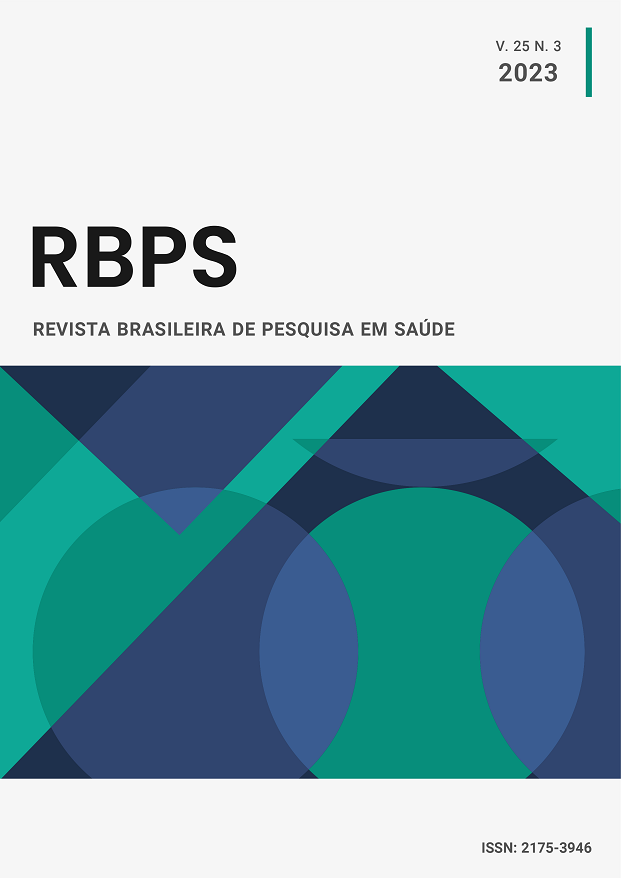Dose-response relationship of home exercise programs on the functional capacity of the elderly population: an integrative review
DOI:
https://doi.org/10.47456/rbps.v25i1.40110Keywords:
Aging, Exercise, Physical FitnessAbstract
Introduction: Seeking to minimize the functional declines resulting from aging, the literature recommends the performance of physical exercises. In this context, home exercise programs seem to be an alternative, especially when access to training centers is restricted. However, it is not known which is the most appropriate dose-response relationship from the manipulation of training variables to promote improvements in the functional capacity of the elderly population. Objective: to analyze the characteristics and the dose-response relationship of the training variables of a home exercise program on the functional capacity of the elderly population. Methods: a search was carried out in the Pubmed/Medline and Virtual Health Library databases of randomized clinical trials published in any language between January 2020 and December 2022. The search criteria were established according to the analysis strategy of the Population, Intervention, Comparator Outcomes and Study Design. Results: 1,427 articles were identified, of which three met the eligibility criteria. Among the main results, balance improved in all studies, in addition, there was an improvement in lower limb muscle strength, upper limb muscle strength and functional mobility. Conclusion: home exercise programs lasting six to ten weeks, performed two to three times a week, with sessions between 35 and 50 minutes involving balance, muscle strength, stretching and gait exercises promote improvements in the functional capacity of the elderly population, especially in balance.
Downloads
References
Fleck SJ, Kraemer WJ. Fudamentos do Treinamento de Força Muscular. 4. ed. Porto Alegre: Artmed Editora; 2017.
Fiedler MM, Peres KG. Capacidade funcional e fatores associa¬dos em idosos do Sul do Brasil: Um estudo de base populacional. Cadernos de Saude Publica. 2008;24(2):409-415.
Imaginário C. et al. Functional capacity and self‐care profiles of older people in senior care homes. Scandinavian Journal of Caring Sciences. 2020;34(1):69-77.
Cruz-Jentoft AJ, Bahat G, Bauer J, Boirie Y, Bruyère O, Ceder¬holm T, et al. Sarcopenia: revised European consensus on defini¬tion and diagnosis. Age and Ageing. 2019;48(1):16-31.
Izquierdo M, Merchant RA, Morley JE, Anker SD, Aprahamian I, Arai H, et al. International Exercise Recommendations in Older Adults (ICFSR): Expert Consensus Guidelines. The Jour¬nal of Nutrition, Health & Aging. 2021;25(7):824-853.
Oikawa SY, Holloway TM, Phillips SM. The Impact of Step Reduction on Muscle Health in Aging: Protein and Exercise as Countermeasures. Frontiers in Nutrition. 2019;6(75):1-11.
Brasil. Ministério da Saúde. Guia de Atividade Física para a População Brasileira. Brasília, DF: Ministério da Saúde; 2021.
Eckstrom E, et al. Physical activity and healthy aging. Clinics in Geriatric Medicine. 2020;36(4):671-683.
Lacroix A, Hortoba´gyi T, Beurskens R, Granacher U. Effects of Supervised vs. Unsupervised Training Programs on Balance and Muscle Strength in Older Adults: A Systematic Review and Meta-Analysis. Sports Medicine. 2017;47(11):2341-2361. DOI 10.1007/s40279-017-0747-6.
Padala KP, Padala PR, Lensing SY, Dennis RA, Bopp MM, Rober¬son PK, et al. Home-Based Exercise Program Improves Balance and Fear of Falling in Community-Dwelling Older Adults with Mild Alzheimer’s Disease: A Pilot Study. Journal of Alzheimer’s Disease. 2017;59(2):565-574. DOI 10.3233/JAD-170120.
Piotrowicz E, Baranowski R, Bilinska M , Stepnowska M, Piotrowska M , Wójcik A, et al. A new model of home-based tele¬monitored cardiac rehabilitation in patients with heart failure: effectiveness, quality of life, and adherence. European Journal of Heart Failure. 2010;12(2):164-171. DOI:10.1093/eurjhf/hfp181.
Anderson L, Sharp GA, Norton RJ, Dalal H, Dean SG, Jolly K, et al. Home-based versus centre-based cardiac rehabilitation ( Review ) Summary of findings for the main comparison. Cochrane Data¬base of Systematic Reviews. 2017;6(CD007130):1-155.
13. Seixas MB, Ricardo DR, Ramos PS. Reabilitação Domiciliar Com Exercício Não Supervisionado Na Dpoc: Revisão Sistemática. Revista Brasileira de Medicina do Esporte. 2016;22(4):320-325. https://doi.org/10.1590/1517-869220162204150806.
14. Thiebaud RS, Funk MD, Abe T. Home-based resistance training for older adults: A systematic review. Geriatrics and Gerontology International. 2014;14(4):750-757. DOI: 10.1111/ggi.12326.
15. Kaushal N, Langlois F, Desjardins-Crépeau L, Hagger MS, Bherer L. Investigating dose–response effects of multimodal exercise programs on health-related quality of life in older adults. Clinical Interventions in Aging. 2019;14:209-217. DOI: 10.2147/CIA.S187534.
16. Fiorini N, Lipman DJ, Lu Z. Towards PubMed 2.0. eLife. 2017;6:4-7.
17. Brasil. Ministério da Saúde. Portal regional da BVS. Brasília, DF: Ministério da Saúde; 2020 [acesso em 4 mar. 2023]. Dis¬ponível em: https://bvsalud.org/sobre-o-portal/#:~:text=O%20 Portal%20Regional%20da%20BVS,ingl%C3%AAs%2C%20por¬tugu%C3%AAs%20e%20espanhol
18. Santos CM, Pimenta CA, Nobre MR. The PICO strategy for the research question construction and evidence search. Revista Latino-Americana de Enfermagem. 2007;15(3):508–511.
19. Hopia H, Latvala E, Liimatainen L. Reviewing the methodology of an integrative review. Scandinavian Journal of Caring Sci¬ences. 2016;30(4):662-669.
20. Pepera G, Mpea C, Krinta K, Peristeropoulos A ,Antoniou V. Effects of multicomponent exercise training intervention on hemodynamic and physical function in older residents of long-term care facilities: A multicenter randomized clinical con¬trolled trial. Journal of Bodywork and Movement Therapies. 2021;28:231-237.
21. Zengin Alpozgen A, Kardes K , Acikbas E, Demirhan F, Sagir K, Avcil E. The effectiveness of synchronous tele-exercise to main¬tain the physical fitness, quality of life, and mood of older people - a randomized and controlled study. European Geriatric Medi¬cine. 2022;13(5):1177-1185.
22. Mahjur M, Norasteh AA. Effects of home-based specific and comprehensive balance-training programs on balance and func¬tional status in healthy older adults. Experimental Gerontology. 2022;159:111701.
23. Sampaio AR, Farinatti PT, Oliveira RB. Relação dose-resposta entre nível de atividade física e desfechos em saúde. Revista Hos¬pital Universitário Pedro Ernesto. 2013;12(4):111-123.
24. Andrews RM, Tan EJ, Varma VR, Rebok GW, Romani WA, Seeman TE, et al. Positive aging expectations are associated with physical activity among urban-dwelling older adults. Gerontolo¬gist. 2018;57(S2):178-186.
25. Mañas A, Gómez-Redondo P, Valenzuela PL, Morales JS, Lucía A, Ara I. Unsupervised home-based resistance training for community-dwelling older adults: A systematic review and meta-analysis of randomized controlled trials. Ageing Research Reviews. 2021;69:101368.
26. Mahjur M, Norasteh AA. The Effect of Unsupervised Home- Based Exercise Training on Physical Functioning Outcomes in Older Adults: A Systematic Review and Meta-Analysis of Ran¬domized Controlled Trials. Biological Research for Nursing. 2021;23(3):504-512.
27. Denton F, Power S, Waddell A , Birkett S, Duncan M, Harwood A, et al. Is it really home‐based? A commentary on the necessity for accurate definitions across exercise and physical activity pro¬grammes. International Journal of Environmental Research and Public Health. 2021;18(17).
Downloads
Published
How to Cite
Issue
Section
License
Copyright (c) 2023 Brazilian Journal of Health Research

This work is licensed under a Creative Commons Attribution-NonCommercial-NoDerivatives 4.0 International License.
Authors and reviewers must disclose any financial, professional, or personal conflicts of interest that could influence the results or interpretations of the work. This information will be treated confidentially and disclosed only as necessary to ensure transparency and impartiality in the publication process.
Copyright
RBPS adheres to the CC-BY-NC 4.0 license, meaning authors retain copyright of their work submitted to the journal.
- Originality Declaration: Authors must declare that their submission is original, has not been previously published, and is not under review elsewhere.
- Publication Rights: Upon submission, authors grant RBPS the exclusive right of first publication, subject to peer review.
- Additional Agreements: Authors may enter into non-exclusive agreements for the distribution of the RBPS-published version (e.g., in institutional repositories or as book chapters), provided the original authorship and publication by RBPS are acknowledged.
Authors are encouraged to share their work online (e.g., institutional repositories or personal websites) after initial publication in RBPS, with appropriate citation of authorship and original publication.
Under the CC-BY-NC 4.0 license, readers have the rights to:
- Share: Copy and redistribute the material in any medium or format.
- Adapt: Remix, transform, and build upon the material.
These rights cannot be revoked, provided the following terms are met:
- Attribution: Proper credit must be given, a link to the license provided, and any changes clearly indicated.
- Non-Commercial: The material cannot be used for commercial purposes.
- No Additional Restrictions: No legal or technological measures may be applied to restrict others from doing anything the license permits.

























